|

by
Liz Kimbrough
December 08,
2020
from
MongaBay Website
Italian version
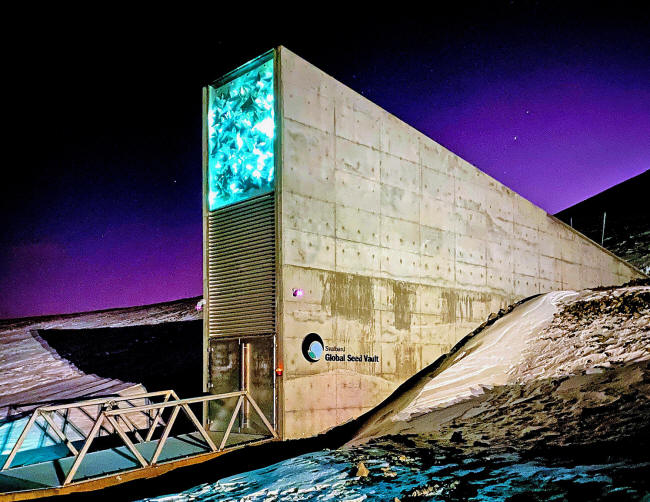
Image of the entrance to the Svalbard Global Seed
in Svalbard, Norway, a remote archipelago in the Arctic Ocean.
Photo by Subiet via Wikimedia Commons (CC BY-SA 4.0).
-
The global network of plant gene banks has shown
resilience and cooperation, growing in importance as
an estimated 40% of plant species are threatened
with extinction and the crops used to feed the world
become less diverse.
-
A newly published paper documents the rescue mission
of seeds from a gene bank in Syria to the Svalbard
Global Seed Vault in Norway, and discusses the
extensive global system for conserving crop
diversity and why it is imperative to do so.
-
While Svalbard's vaults store crop seeds, the
Millennium Seed Bank at the Royal Botanic Gardens,
Kew, is the world's largest wild seed conservation
project, now celebrating its 20th anniversary.
-
Gene banks are an important part of conservation,
but they are not sufficient on their own, one expert
says; the wild places and agro-ecosystems these
plants come from must also be protected.
By the time the
war broke out in Syria, researchers
from the International Center for Agricultural Research in the
Dry Areas (ICARDA)
had already duplicated and safely transported most of their genetic
treasure trove to the
Svalbard Global Seed Vault
(investments by
Bill Gates,
Rockefeller and GMO Giants) on the remote
Arctic island of Spitsbergen, Norway.
The ICARDA facility in Tel Hadia, just south of Aleppo, Syria, once
stored the largest collection of crop diversity from the Fertile
Crescent, one of the world's earliest centers of agriculture.
When the facility was
abandoned in 2014, more than 80% of its collection was backed up in
the Norwegian vault.
"When the Arab Spring
started, Syria was still considered a very secure and stable
country, and then it became complete chaos, as we know," Ola
Westengen, an associate professor at the Norwegian
University of Life Science who was coordinator of operations
and management at the Svalbard Global Seed Bank at the time of
the seed rescue, told Mongabay.
"[B]ut one should not
give the impression that the seeds were somehow smuggled out or
sent out in a clandestine way, everything was by the book."
The safe and peaceful
transfer of the samples from Syria, despite extreme conditions,
Westengen says, is a testament to how well the international system
of gene banks is working.
Westengen is the co-author of a newly published paper (Safeguarding
a Global Seed Heritage from Syria to Svalbard) in the
journal Nature Plants that documents the seed rescue mission and
lessons learned from the operation, which, the paper says,
illustrates the links between food security, sociopolitical
stability, and climate change.
The paper also discusses
the extensive global system for conserving crop diversity and why it
is imperative to do so.
Diversity in farmers' fields is decreasing, with an
estimated 90% of humanity's caloric
intake reliant on just rice, maize and wheat.
Threats to crop diversity
are addressed in international conservation goals such as,
-
the U.N.'s
Convention on Biological Diversity (CBD)
-
the International
Treaty on Plant Genetic Resources for Food and Agriculture (Plant
Treaty)
-
the Sustainable
Development Goals (SDGs)
A network of
international centers preserves regional plant diversity and makes
these seeds available to researchers and plant breeders under the
conditions of the Plant Treaty, not only to respond to
regional disasters but also to develop new varieties that are
resilient in the face of challenges such as drought and disease.
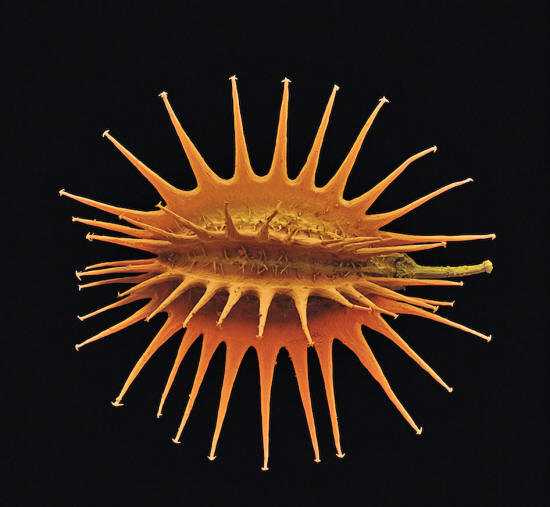 mmm mmm
The seed of a wild relative of the carrot, Daucus carota.
This plant is not edible,
but
it may have genetic traits that could be of use.
Because it can withstand harsher growing conditions
than the supermarket carrot,
its genes may be used to create carrot varieties
that can withstand pressures from climate change.
Photo by Rob Kesseler.
Ideally, important digital information is backed up to "the cloud"
or a hard drive.
Likewise, the
important crop genetics from regional seed banks are backed up
in the
Svalbard Global Seed Vault...
The vault, built inside a
mountain on the remote Arctic archipelago of Svalbard, opened in
2008 with the intention of being a politically neutral and safe
location to protect the world's crop diversity.
Samples sent here are
duplicates from seed and gene banks, research facilities, and
communities around the world, ranging from large institutions like
ICARDA, to the Cherokee Nation, who, this year, became the first
tribe in the U.S. to send important heirloom seeds to Svalbard.
But unlike files on a hard drive, seeds in a vault cannot be
stored and forgotten...!
Even in the ideal,
supercooled (-18°C, -0.4°F) conditions of the Svalbard vault,
seeds have a shelf life...
It is up to each
institution providing seeds to be sure the collections in the vaults
are regularly updated with fresh, viable samples.
"In some of the
stories about the seed vault, you get the impression that this
is like a time capsule," Westengen said.
"But the seed vault
only makes sense as part of a kind of dynamic system for
conserving and keeping the seeds viable... all seeds need
to be regenerated and grown out in an environment where
they will maintain their genetic integrity.
And that's a much
more demanding job."
In 2015, the ICARDA
facilities in Lebanon and Morocco began undertaking the mammoth task
of regenerating in the field the plants rescued from Syria, an
operation requiring complex logistics and large areas to regrow
thousands of different species.
But they have been
successful...
All of the safety
duplicates stored in Svalbard were regenerated by September of this
year (2020).
"It has been a
massive effort," Mariana Yazbek, co-author of the paper
and gene bank manager at the ICARDA facility in Lebanon, told
Mongabay.
"[O]ur team
sacrificed nights and weekends sometimes to ensure this limited
resource of seeds was regenerated... We are reaping the benefits
of this work now, quite literally."
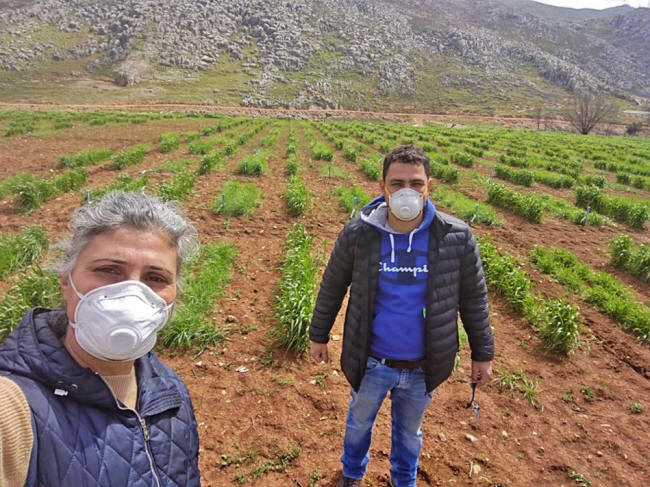
ICARDA Lebanon Genebank Manager Mariana Yazbek (left),
says workers have continued to come to work on a rotating schedule
to keep plants alive throughout the COVID-19 lockdowns.
Image courtesy of ICARDA.
This year, gene banks have faced the added challenge of keeping
critical plants alive during the
COVID-19 'pandemic'.
While some seeds can be
left on the shelves for months or even years, conserving roots,
tubers and other crops that are not grown from seed such as,
potatoes, cassava
(yuca),
yams and some bananas,
...require more
attention.
These plants cannot be
stored for long, and are not backed up at Svalbard, so they must be
grown nearly continuously.
When the lockdowns began
in Lebanon, for instance, ICARDA staff worked on a rotating
schedule, traveling only between their homes and work to keep the
plants alive.
At another facility, the International Center for Tropical
Agriculture (CIAT)
in Colombia, researchers preserve many important tropical-adapted
crops such as cassava.
CIAT has many different
genotypes of cassava, all cultivated without seeds, requiring daily
work.
This year, its staff of
900 was moved to a rotating schedule, with about 300 people coming
in each day to keep plants alive and critical experiments running.
"Perhaps you think
that the middle of a global 'pandemic' is not an appropriate
time to be discussing seed banks. Think again,"
...Luigi Guarino, director of science, and
Charlotte Lusty,
head of programs and gene bank platform coordinator at
Crop Trust, an organization
that supports the Svalbard Global Seed Vault as well as
genebanks around the world, wrote in
Landscape News.
"One thing is
certain, to mitigate the effects of future shocks of the kind
we're currently experiencing, and to allow us to bounce back
from them, there needs to be diversity in all parts of the food
chain."
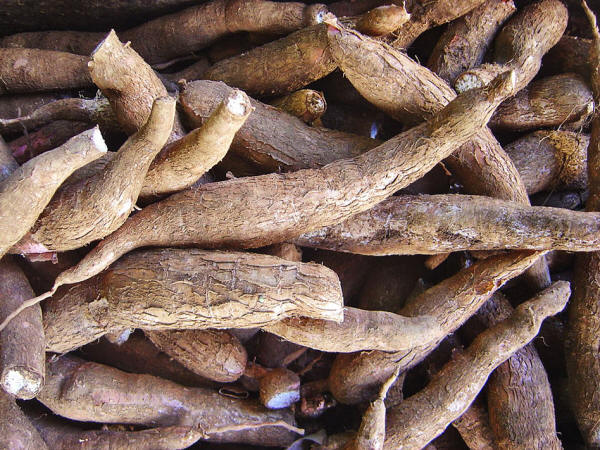
Cassava, also called yuca,
is an
important global food crop
that
cannot be stored using seeds.
Photo
by David Monniaux via Wikimedia Commons
(CC
BY-SA 3.0).
Guarino and Lusty say that maintaining crop diversity is an
essential task, even during a 'pandemic', to future-proof the
world's crops from impacts related to climate change, natural
disasters, or conflict.
"There is kind of a
global system that, unfortunately, very few people appreciate
until there is a tragedy," Joseph Tohme, agrobiodiversity
research area director at CIAT, told Mongabay.
"Every center can
provide you kind of stories...
In our case, we had a
major project called Seeds of Hope for Rwanda, because
during and after the genocide, Rwanda lost a major collection of
beans."
One tragedy, the
human-caused annihilation of global plant and animal species, known
as the sixth mass extinction, is currently underway.
An estimated 40% of
plant species are
threatened with extinction,
according to a report released by the Royal Botanic Gardens,
Kew.
The Royal Botanic Gardens, Kew's
Millennium Seed Bank is working
to save some of that diversity.
While the Svalbard
vault store crop seeds, the Millenium Seed Bank, located
in Wakehurst, U.K, safeguards seeds of the planet's imperiled wild
plants.
The Millenium Seed Bank, the world's largest wild seed
conservation project, celebrated its 20th anniversary
this year.
Its vault, built to
withstand bombs, radiation and floods, holds 2.4 billion seeds from
39,681 species, coming from 190 countries and territories.
The facility and its
partners say they have helped to protect 16% of the world's
seed-bearing plants.
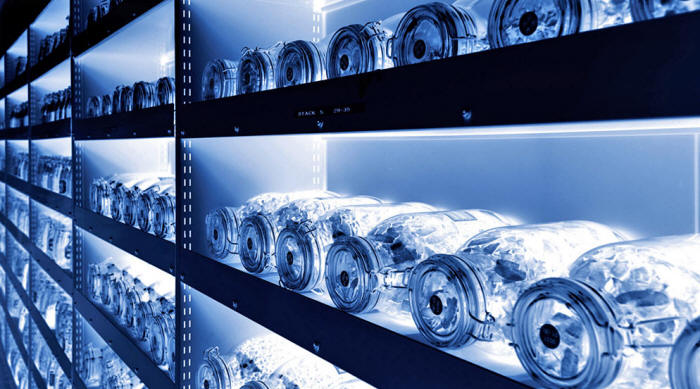
Seeds of the world's wild plants
in cold
storage at the Kew Millennium Seed Bank,
Photo
courtesy of Royal Botanical Gardens Kew.
Among its collection are eight species now extinct in the wild.
One of these, the last
known wild yellow fatu flower (Abutilon pitcairnense), was
taken out by a landslide on Pitcairn Island in the Southern Central
Pacific, the only place where it was found.
The seeds were already
saved at Millennium Seed Bank, and are now cultivated in its
greenhouses.
"If that material
hadn't already been collected, then when that landslide wiped
out the one remaining plant, we would have had nothing.
We would have had no
trace of that species, which is now extinct in the wild,"
Elinor Breman, senior research leader in seed conservation
at the Millennium Seed Bank, told Mongabay.
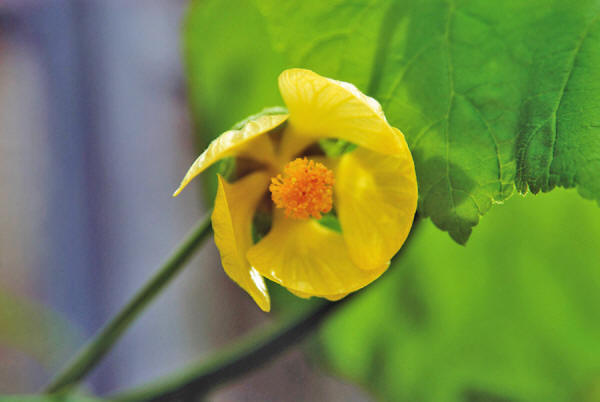
The wild yellow fatu flower (Abutilon pitcairnense)
is
now considered extinct in the wild,
but lives on at the Kew Royal Botanical Gardens.
Photo by Marcella Corcoran.
Like the Svalbard vault, the Millennium Seed Bank has
responded in the wake of catastrophe.
The massive bushfires in
Australia earlier this year burned 23,200 hectares (57,300 acres) in
Cudlee Creek near Adelaide.
The Millennium
Seed Bank sent backup seeds of clover glycine (Glycine
latrobeana), a rare, wild pea, to its partners in Australia so
that the plant could be cultivated and used to restore the
ecosystem.
Research on the science of seed and gene banking is ongoing at
the Millennium Seed Bank, including the development of
cryopreservation methods to store roots and tubers.
Along with their
international partners, they are researching useful plant traits and
testing species' responses to environmental stressors such as
drought and higher temperatures, predicted to increase as the
climate changes.
The Millennium Seed Bank also safeguards some of the wild
relatives of crops, the plants from which many of our foods were
cultivated.
Conserving crop diversity
involves protecting the entire gene pool of a crop and that includes
its wild ancestors.
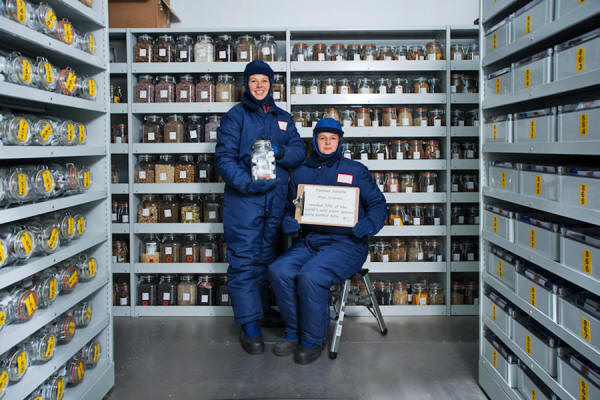
Researchers in the -20°C Kew Millennium Seed Bank vault.
The sign reads, "Yunan banana (Musa itinerans)…
marked 10% of the world's plant species being banked here."
Photo courtesy of Royal Botanical Gardens Kew.
Gene banks are an important part of conservation, says Westengen,
but they are not sufficient on their own.
A continuum exists
between ex-situ (off-site) and in in-situ (in-place) conservation,
so the wild places and agro-ecosystems these plants come from must
also be protected.
"This is something
that we all depend on. This is a common heritage. It's not
something that especially benefits any one side in a conflict,"
Westengen said.
"The issue of seeds
is actually quite politicized globally... but
pretty much everyone agrees that we need to conserve this
diversity."
Citation
-
Westengen, O. T.,
Lusty, C., Yazbek, M., Amri, A., & Asdal, Å. (2020).
Safeguarding a global seed heritage
from Syria to Svalbard. Nature Plants, 6(11),
1311-1317. doi:10.1038/s41477-020-00802-z
|








